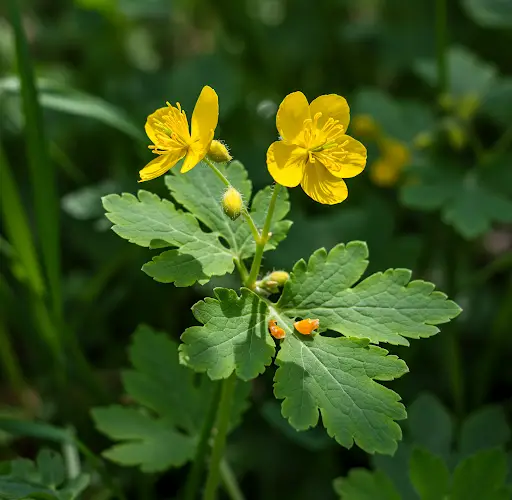Greater Celandine (Chelidonium majus): A Medicinal Herb with Potent Properties
Greater celandine (Chelidonium majus) is a perennial herbaceous plant belonging to the poppy family (Papaveraceae). This medicinal herb has been widely used for centuries, particularly in traditional Western Pharmacopoeia and Chinese medicine. It is best known for its efficacy in treating viral warts but has also been utilized for various other therapeutic applications.
Botanical Characteristics
Greater celandine grows as a wild herb from spring to autumn, reaching an average height of around 70 cm. It is easily recognizable by its bright yellow flowers, which consist of four petals. The plant has an erect and branched stem covered with fine hairs. One of its most notable features is the orange or yellow latex that exudes when the plant is broken. This milky sap contains active ingredients, including alkaloids, that contribute to its wart-removing properties. Some of these alkaloids share similarities with opium from the poppy plant, making celandine a potent herb with both medicinal benefits and potential toxicity.
Habitat and Distribution
Greater celandine is a widespread plant found in many regions of Europe and western Asia. It thrives in meadows, forests, roadsides, and near human dwellings. It is also commonly seen on arable land, often mistaken for a common weed. Despite its invasive growth habit, it has been valued in herbal medicine for centuries.
Traditional Uses and Wart Treatment
One of the most well-known applications of greater celandine is for the removal of warts. The plant’s yellow sap is applied directly to the wart, ideally twice a day. Care must be taken to apply it only to the wart itself and not the surrounding skin, as the sap can cause irritation in some individuals. The plant’s toxic compounds make it highly effective against warts, corns, and similar skin growths. Some people also use it to treat corns and calluses on the feet.
However, fresh sap is only available during the growing season in spring and summer. To ensure year-round use, many herbalists recommend preparing a tincture, which allows for extended medicinal applications beyond the plant’s natural growth period.
Preparation of Greater Celandine Tincture
A tincture can be made to preserve the active properties of greater celandine for external use. The process involves the following steps:
- Harvest and dry the aerial parts of the plant.
- Finely chop the dried herb and fill half of a clean glass jar with it.
- Pour 70% alcohol or homemade brandy over the herb, filling the jar to the top.
- Seal the jar and place it in a dark location for three weeks to allow the active compounds to infuse into the alcohol.
- After three weeks, strain the tincture and store it in a dark glass bottle.
This tincture can be applied directly to warts, corns, and calluses multiple times a day for effective treatment. It is also used to treat certain skin infections and eczema. For treating inflammatory skin conditions such as eczema, the tincture should be diluted before use. A common dilution involves dissolving 30 drops of tincture in 100 ml of boiled and cooled water. This solution can then be applied to the affected area in the form of a compress or wrap.
Potential Uses for Genital Warts and Skin Infections
Some individuals use greater celandine tincture for the treatment of condyloma (genital warts), but this should only be done under professional guidance due to the sensitivity of the area and the potential for irritation.
Internal Use: Risks and Cautions
Despite its widespread external use, internal consumption of greater celandine remains controversial. The fresh plant and its latex are toxic if ingested, and caution is necessary. However, some herbalists recommend internal use in controlled doses, specifically in the form of dried herbs or tinctures.
For internal medicinal use, only dried greater celandine should be used. Traditionally, it has been utilized in the treatment of:
- Stomach pain
- Gallbladder and bile-related disorders
- Liver diseases
- Bacterial infections, particularly against gram-positive bacteria
- Cysts, wounds, and tumors (with anecdotal evidence but limited scientific support)
Internal Use Guidelines and Precautions
If consumed internally, celandine must be taken in precise therapeutic doses to avoid toxicity. A commonly recommended dosage for tincture use is:
- Dilute 10 drops of tincture in a glass of water twice a day.
- The maximum daily intake of dried celandine should not exceed 2-4 grams.
- The treatment should be limited to three weeks, followed by a one-week break before resuming use.
Exceeding the recommended dosage can lead to nausea, vomiting, diarrhea, and potential liver toxicity. If any adverse symptoms occur, the use of the herb should be stopped immediately. Due to its potent effects, internal use is best carried out under the supervision of an experienced herbalist or healthcare professional.
Scientific Research and Future Studies
While traditional medicine has long valued greater celandine, modern scientific research on its medicinal properties is still limited. Some studies suggest that it has antimicrobial and anti-inflammatory properties, making it a potential candidate for further medical applications. There is also ongoing investigation into its possible anticancer effects, particularly regarding its impact on tumor growth. However, more clinical trials are needed to validate these findings.
Conclusion
Greater celandine is a powerful medicinal herb with a long history of use in traditional medicine. Its most notable application is the treatment of warts, but it is also used for other skin conditions, digestive disorders, and liver health. However, due to its toxic alkaloids, careful usage is essential, especially when taken internally.
While external applications such as fresh sap or tincture are generally safe when used correctly, internal use requires precise dosing and professional oversight. With more scientific research, greater celandine may prove to have even broader therapeutic benefits, reinforcing its importance in herbal medicine. Until then, caution and traditional knowledge remain crucial when using this remarkable plant.



